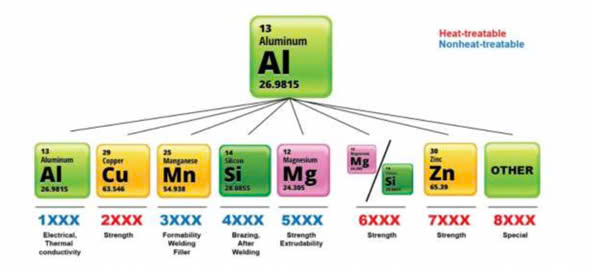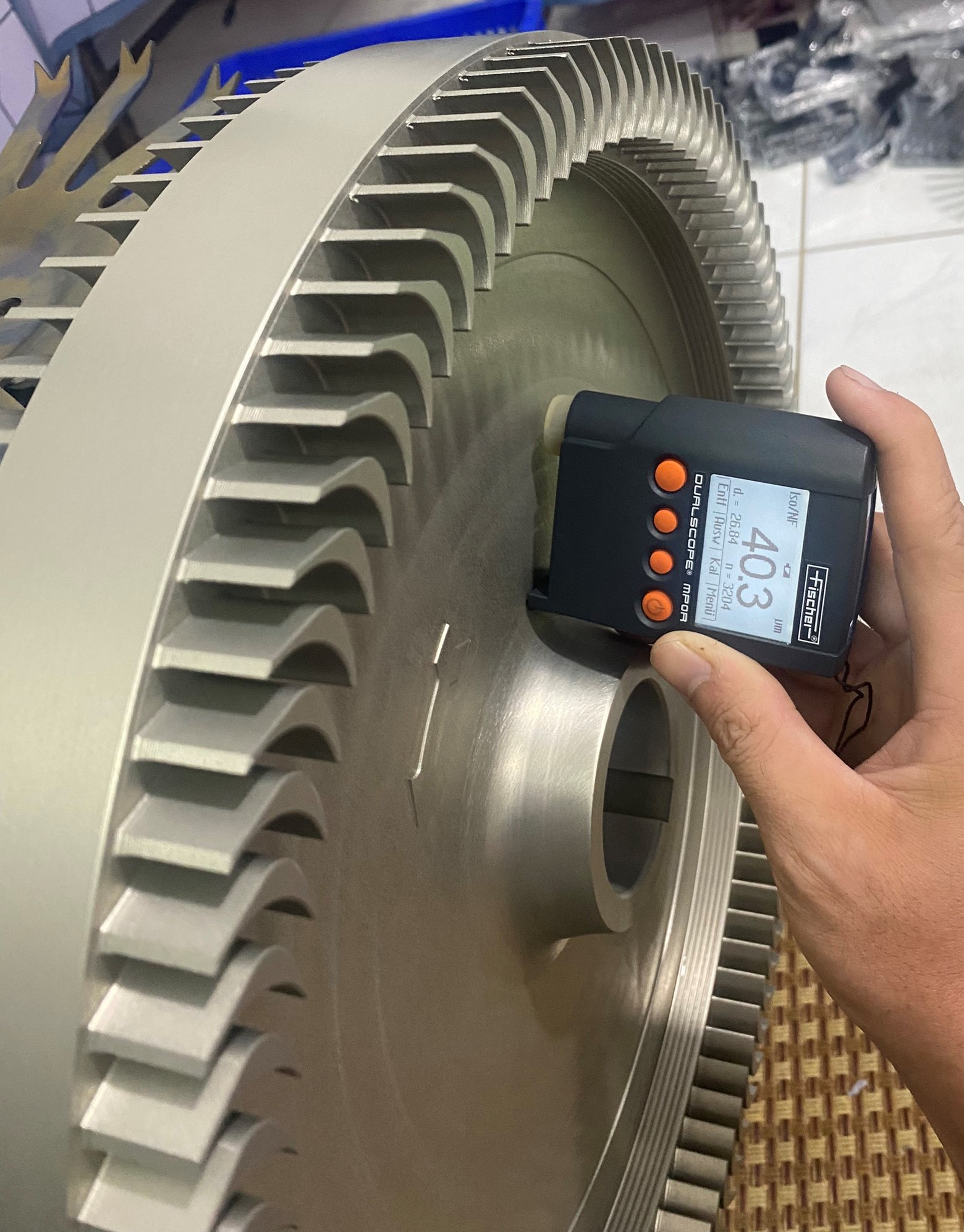CLASSIFICATION OF ALUMINUM AND ALUMINUM ALLOYS
- PROBLEM STATEMENT
Aluminum is used in many different industrial fields due to its light weight and good corrosion resistance, such as: shipbuilding, tanks, automobiles, aviation and many other common structures. Depending on each specific application, the appropriate type of aluminum will be selected. With different properties and chemical composition, each type of aluminum will have different behaviors when welding. Therefore, classifying aluminum to understand the properties of each type is very important, from which there will be appropriate welding material choices to create welds with the desired quality.
This article shows how to classify basic and common aluminum material groups and some of their characteristic properties.
- CLASSIFICATION OF ALUMINUM ALLOYS
When manufacturing aluminum, manufacturers often add alloying elements (such as Cu, Mn, Mg, Si, Sn, Zn) to improve some properties of aluminum. However, based on the manufacturing and usage methods, we divide it into two main groups: wrought aluminum alloy and cast aluminum alloy .
The easiest way to distinguish between these two groups is: Cast aluminum alloys are made by melting bauxite ore in a furnace, then pure aluminum is separated and poured into a mold with alloying elements to create the desired casting, this process is quite complicated and energy-consuming. Meanwhile, wrought aluminum alloys are made by melting aluminum ingots with alloying elements, then casting them into large sheets before rolling, forging or drawing them into different shaped billets. Here, cast aluminum alloys usually contain more alloying elements, have a lower melting temperature, and are also less durable than wrought aluminum because they cannot completely eliminate defects when casting. Therefore, in reality, about 85% of alloys used are wrought aluminum alloys.
2.1. Properties of alloying elements
The basic alloying elements used to improve the properties of aluminum alloys include: Cu, Si, Mn, Mg and Zn. Below are the properties of each element:
- Copper (Cu): Improves strength and formability.
- Silicon (Si): Reduces melting temperature, increases fluidity, improves casting properties.
- Manganese (Mn): Increases strength and toughness.
- Magnesium (Mg): Improves strength, and corrosion resistance.
- Mg/Si: Increases strength, formability and tensile strength.
- Zinc (Zn): when combined with Mg and Cu will help improve durability.
In addition, some other elements such as: Cr, Zr, V, Ni, Ti, Sc help smooth the grain structure. Element Fe helps reduce residual stress. Elements: Se, Bi, Pb, Sn: Improve machinability but reduce weldability.
2.2 . Wrought aluminum alloy
Depending on the manufacturing style, forged aluminum billets have different shapes, including: thin sheet, plate, foil, wire or rod, drawn or forged billets…
Depending on the alloy element composition, they can be grouped into 7 main groups and a special group (group 8) as shown below. Groups 2, 6, 7, 8 are heat-treatable groups to improve some mechanical properties, while groups 1, 3, 4, 5 are nonheat-treatable.
For example : Aluminum 5083 means group 5, Aluminum-Magnesium alloy (Al/Mg), original version (0), has alloy number 83. Aluminum 5183 is the first variant version of aluminum 5083.
Note : In the case of special heat group 1xxx which is the Pure Aluminum group, the last 2 characters show the minimum % of aluminum above 99%. For example: Aluminum 1350 has 99.50% pure aluminum.
2.3. Cast aluminum alloy
As mentioned above, cast aluminum alloys are made from bauxite ore. The aluminum casting process can be carried out in sand casting, die casting or investment casting. Cast aluminum alloys include 9 groups. Similar to wrought aluminum alloys, they are divided into two groups: Non-heat-treatable cast aluminum alloys include groups 2, 3, 4 and 7; Heat-treatable cast aluminum alloys include groups 1, 5, 8, 9. The groups are classified according to the specific alloying element composition as shown below.
For example : aluminum A356.0, the character “A” shows that this is a modified version of aluminum 356.0. The number “3” indicates that this is the A3xx.x group, which is an aluminum + Copper and/or Magnesium alloy. The character “56” indicates the group name in the 3xx.x alloy group. And the character “.0” indicates that the final billet is in the form of a cast billet, not in the form of an ingot/bar.
- Designation system for heat treatable and non-heat treatable aluminum alloys
Each group of aluminum has its own designation. Sometimes, after the aluminum alloy designation, there are letters such as “F”, “O”, “T” or “H”. Their meaning is to clarify the type of aluminum. Specifically:
- XXXX- F: is an aluminum alloy belonging to the group with durability according to production/manufacturing.
- XXXX- O: is an annealed aluminum alloy. This group usually has the lowest strength.
- XXXX- Txx: is an aluminum alloy belonging to the heat treatable group.
- XXXX- Hxx: is an aluminum alloy that belongs to the cold-hardened group and cannot be heat-treated.
Wrought aluminum alloys and cast aluminum alloys use the same designation system for non-heat-treatable aluminum alloys and heat-treatable aluminum alloys. Specifically, as follows:
3.1. Non-heat-treatable aluminum alloy
For non-heat-treatable aluminium alloys, their initial strength is determined by the alloying elements. Strength can then be increased (but ductility reduced) by cold-forming processes such as rolling, forging or drawing, sometimes called cold-working, strain-harening. After this state, aluminium is designated with the letter “F” (as-fabricated). However, these alloys are finally heat-treated to a stable temperature to ensure that the mechanical properties do not change over time (this is called temper stabilizing), with these aluminium alloys being designated with the letter “O” (annealed).
With this group of alloys, when welding, the heat affected zone (HAZ) will be annealed due to the influence of the arc heat, so the mechanical properties of this area will decrease. If heat treatment is carried out after welding, it will affect the strength obtained due to the hardening process, because at high temperatures, phenomena such as: Redistribution of grain structure (recovery), recrystallization and formation of new grains (recrystallization), or increase in grain size (grain growth) can occur. Therefore, it is recommended that this group of alloys not be heat treated after welding.
Non-heat treatable aluminum is usually denoted as: XXXX-Hxx
In signature:
- The letter “H” that follows means the aluminum has been “strain hardened” during the manufacturing process.
- The number following the letter “H” indicates the treatment method during or after hardening. Specifically:
- H1: Strain Hardened only aluminum alloy.
- H2: Strain Hardened and partially annealed aluminum alloy.
- H3: Strain hardened and stabilized aluminum alloy.
- The second number after the letter “H” indicates the degree of strain hardening, specifically:
- Hx2: hardening ¼
- Hx4: Hardening ½
- Hx6: Hardening ¾
- Hx8: Full hard.
- Hx9: Extra hard.
3.2. Heat-treatable aluminum alloy
For heat-treatable aluminum alloys, the strength is created by alloying the alloying elements with pure aluminum. The alloying elements can be independent or combined to dissolve in the form of a solid solution with aluminum when the temperature increases. However, this group of aluminum alloys is very sensitive to temperature, if kept at high temperatures for a long time, it will lead to a significant decrease in strength. Therefore, when welding, it is necessary to pay attention to strictly controlling the heat into the weld through controlling the heating, the energy of the weld, and the temperature between the welds. It is because of this mechanism that the strength of heat-treatable aluminum can be significantly increased by heat-treating at high temperatures (from 480 – 560 o C, depending on the alloy type) to increase the ability to dissolve the alloying elements into aluminum in the form of a solid solution mixture, then cool quickly (usually quenched in water) to maintain the dissolved state of the alloying elements. Depending on the case, after the above heat treatment, it is possible to combine the precipitation heat-treatment method or sometimes called artificial aging, by heating with controlled time at a temperature of about 120 – 200 o C, to help increase and stabilize the strength of the aluminum alloy. Note that, if the aluminum alloy is considered for post-weld heat treatment, the selection of a suitable welding material that is capable of adapting to post-weld heat treatment is very important.
Note : By adding Copper (Cu) and/or Magnesium (Mg) elements to the Aluminum/Silicon alloy (Group 4xxxx), the alloy becomes heat treatable.
Heat treatable aluminum is commonly designated as: XXXX-Txxx
In there:
- The letter “T” following means the group is heat treatable.
- The number after the letter “T” has the following meaning:
- T1: Aluminum is naturally aged (at room temperature) after rapid cooling (quenching) from high temperatures due to the forming process.
- T2: Aluminum is hardened after being quenched from high temperature by the forming process, then naturally aged.
- T3: Aluminum is heat treated, then hardened and naturally aged.
- T4: Aluminum is heat treated and naturally aged.
- T5: Aluminum artificially aged after cooling from high temperature due to forming process.
- T6: Aluminum heat treated then artificially aged.
- T7: Aluminum is heat treated and then annealed to stabilize the structure.
- T8: Heat treated, hardened and artificially aged aluminum.
- T9: Aluminum heat treated, artificially aged and then hardened.
- T10: Aluminum heat treated, then hardened and artificially aged.
- The second and third characters following the “T” character, if present, indicate the specific thermomechanical treatment method.
At DOMECO, we can cast and process aluminum and aluminum alloy parts – meeting the most demanding and diverse needs of customers. We also have enough equipment to heat treat or hard anodize the surface of the parts to increase corrosion resistance.



Awesome https://is.gd/N1ikS2
https://shorturl.fm/9fnIC
https://shorturl.fm/5JO3e
Share our products, reap the rewards—apply to our affiliate program! https://shorturl.fm/IhwWc